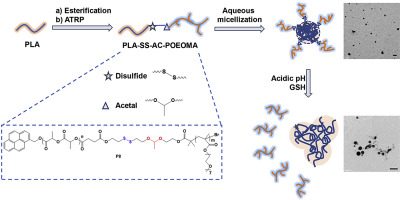Polymer ( IF 4.1 ) Pub Date : 2020-03-18 , DOI: 10.1016/j.polymer.2020.122391 Kamaljeet Kaur Bawa , Arman Moini Jazani , Zhibin Ye , Jung Kwon Oh

|
The development of biocompatible polylactide (PLA)-based block copolymers for constructing self-assembled nanoaggregates degradable in response to endogenous stimuli found in cell environments is promising for enhanced/controlled drug delivery in pharmaceutical science. Despite advances in the synthesis of various PLA-based nanoassemblies featured with only a single stimulus response, the design and development of advanced nanoassemblies integrated with two endogenous stimuli-responsive cleavable linkages for dual stimuli response is challenging. Here we report an approach to the synthesis of a new PLA-based diblock copolymer having dual reduction-cleavable disulfide and acid-labile acetal linkages at the block junction. Key to the approach is the use of a double-head initiator designed uniquely with both acetal and disulfide linkages as well as with both OH and bromine terminal groups. Our comprehensive results from structural analysis and degradation through chemical transition suggest the requirement of a rational combination of controlled polymerization techniques and facile coupling reactions for the synthesis of well-controlled PLA-based diblock copolymer having both disulfide and acetal linkages. The main reason is attributed to the instability of acetal linkages under ROP condition with a tin catalyst at an elevated temperature. The resultant copolymer self-assembles to form shell-sheddable nanoassemblies that are disintegrated in response to dual acid/reduction. This work demonstrates the importance in the development efficient polymerization strategies by utilizing well-established polymerization techniques to synthesize novel functional copolymers with complicated architectures and various functionalities sensitive to reaction environments.
中文翻译:

具有双酸/还原-可裂解连接的可降解PLA基二嵌段共聚物的合成
用于构建可响应细胞环境中的内源性刺激而降解的自组装纳米聚集体的基于生物相容性聚丙交酯(PLA)的嵌段共聚物的开发有望提高/控制药物科学中的药物传递。尽管仅具有单个刺激响应的各种基于PLA的纳米组件的合成取得了进展,但先进的纳米组件的设计和开发与用于双重刺激响应的两个内源性刺激响应可裂解键集成在一起,仍然是一项挑战。在这里,我们报告了一种新的基于PLA的二嵌段共聚物的合成方法,该共聚物在嵌段连接处具有双重还原可裂解的二硫键和酸不稳定的缩醛键。该方法的关键是使用独特设计的双头引发剂,该引发剂具有缩醛和二硫键以及OH和溴端基。我们从结构分析和通过化学转变进行降解得到的综合结果表明,对于具有二硫键和乙缩醛键的可控的PLA基二嵌段共聚物的合成,需要合理结合可控聚合技术和易偶联反应。主要原因归因于在ROP条件下,锡催化剂在高温下,缩醛键的不稳定性。所得的共聚物自组装以形成可脱壳的纳米组件,其响应于双重酸/还原而分解。











































 京公网安备 11010802027423号
京公网安备 11010802027423号